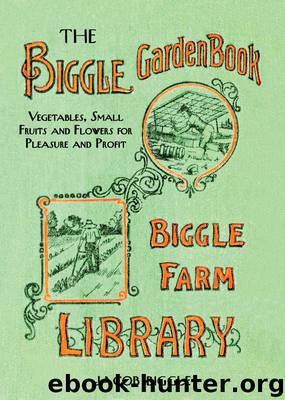The Biggle Garden Book by Jacob Biggle

Author:Jacob Biggle
Language: eng
Format: epub
ISBN: 9781628739121
Publisher: Skyhorse
Published: 2014-01-05T16:00:00+00:00
AFTER RADISHES ARE PULLED, SOME MARKET GARDENERS SOAK THEM IN WATER FOR THREE HOURS TO MAKE THEM EXTRA CRISP
CHAPTER IX
ROOT CROPS
BEET, CARROT, PARSNIP, RADISH, SALSIFY, TURNIP, ETC.
THE long-rooted varieties require a deep, loose soil for their best development (the round or stump-rooted kinds will, of course, do well in shallower soil). Sub-soiling or tile draining are great aids in growing long-rooted crops. Plenty of fertilizer and humus is necessary. These crops are all hardy and therefore permit of early sowing. Give thorough cultivation and hand weeding. Transplanting is seldom practised with these vegetables.
BEET.—There are two kinds—the early-season, quick-growing, round, short-rooted varieties, and the long-rooted, long-season ones. The former are most often grown of late years for market, and may be sown in early spring as an early crop to be followed by something else, or in July or early August as a succession crop after some earlier crop has matured. (The long-rooted kinds are generally sown in May or June in the North, and grow during the entire season.)
Sow in drills about a foot apart for wheel-hoe cultivation; two and a half feet for horse work. Thin the plants gradually to about five inches apart. Cover seed about an inch deep. The seed germinates slowly and a preliminary soaking hastens germination. One ounce of seed will sow about fifty feet of drill; about five pounds to the acre.
Beet “greens” are popular, and are merely young plants that are only partly grown. They are usually obtained in the form of “thinnings” from the rows, leaving the remaining plants to mature. Beet greens are sold in bunches, leaves and all.
Early beets are marketed in various ways—generally tied in bunches of six with part or all of the top attached. Main-crop beets are topped and packed in barrels, etc.
Varieties: Among early kinds, these are my favorites: Early Egyptian, Eclipse, Crimson Globe. Long Blood is a standard late variety.
Insects and diseases: These, as a rule, are seldom troublesome. Wireworms in the soil sometimes hurt the roots (see Chapter VIII for remedies). Root rot is occasionally serious; lime applied to the soil is a help. Beet rust and leaf-spot are fungous troubles on the leaves; remedy, Bordeaux spray applied early. Rotation of crops is useful in all these troubles. CARROT.—For early use, plant the Short Horn, Oxheart and similar short-rooted varieties early in the spring. Main-crop carrots for winter use (Danver’s Half-long, Long Orange, etc.,) may be sown in the North in early June, following early radishes, etc.
Download
This site does not store any files on its server. We only index and link to content provided by other sites. Please contact the content providers to delete copyright contents if any and email us, we'll remove relevant links or contents immediately.
| Container Gardening | Hydroponics |
| Organic | Propagation & Cultivation |
| Topiary | Urban |
| Water Gardens & Ponds |
Turbulence by E. J. Noyes(7031)
The Thirst by Nesbo Jo(5778)
Gerald's Game by Stephen King(3913)
Be in a Treehouse by Pete Nelson(3205)
Marijuana Grower's Handbook by Ed Rosenthal(3114)
The Sprouting Book by Ann Wigmore(3049)
The Red Files by Lee Winter(2908)
The Remains of the Day by Kazuo Ishiguro(2613)
Sharp Objects: A Novel by Gillian Flynn(2439)
Christian (The Protectors Book 1) by L. Ann Marie(2392)
Organic Mushroom Farming and Mycoremediation by Tradd Cotter(2304)
The Culinary Herbal by Susan Belsinger(2055)
Stone Building by Kevin Gardner(1992)
The Starter Garden Handbook by Alice Mary Alvrez(1922)
Lilac Girls by Martha Hall Kelly(1868)
The Unlikely Pilgrimage of Harold Fry by Rachel Joyce(1834)
The Lean Farm Guide to Growing Vegetables: More In-Depth Lean Techniques for Efficient Organic Production by Ben Hartman(1782)
Urban Farming by Thomas Fox(1748)
Backyard Woodland by Josh VanBrakle(1586)
